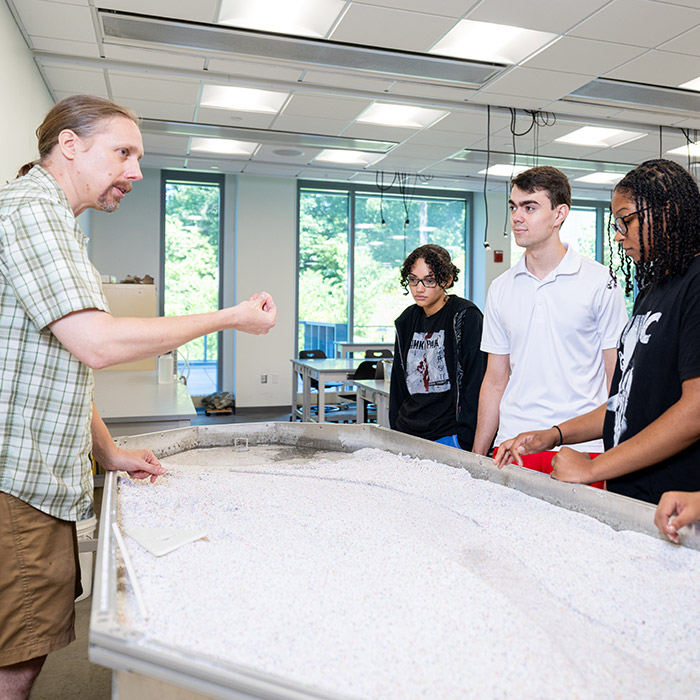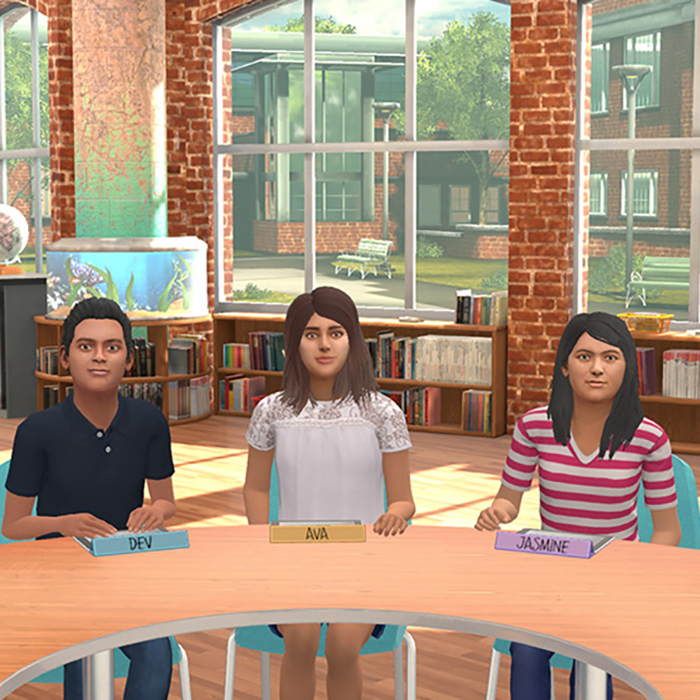Research
Through cutting-edge research, faculty in the Department of Physics, Astronomy, and Geosciences contribute to the latest developments in scientific discoveries and integrate their findings into their classrooms.
PAGS faculty encourge student involvement in research and collaboration across departments and agencies outside of TU.
Student Research
Faculty in PAGS strongly encourage students to become involved in some form of experiential learning as part of their educational program.
This can take the form of:
- research with faculty at TU
- participating in summer research programs at other institutions
- involvement in internships
Students find these experiences transformational, motivating and influential in career decisions.
Research can be part of a student's participation in the departmental honors program.
Connect with a PAGS faculty member about how you can get involved.
Collaboration
Faculty in the Department of Physics, Astronomy, and Geosciences have expertise in all the fields of astronomy, geology, physics and science education. Additionally, the newly constructed Science Complex houses many instructional and research labs equipped with the latest state-of-the-art technology.
The department welcomes collaborations with outside institutions and agencies who wish to partner on research projects. For more information, please contact the department office (410-704-3020, pags AT_TOWSON).
Facilities and Projects
Explore examples of available facilities and current projects related to:
Physics
Labs and projects

Atomic Force Microscopy Lab
In this lab, we are studying Mycelial (fungal) materials, thin films and photonics created in other TU labs, polymers and the force interactions between charged micron-sized objects.

Photonics and Novel Materials Lab
We focus on metamaterials, novel superconductors including metamaterial superconductors and unconventional electromagnetic waves. We use polarization reflectometry and other optical setups, a Vibrating Sample Magnetometer and cryostats, including one with a 9 T superconducting magnet.

Thin Film Fabrication Lab
We work on the fabrication and characterization of functional oxides using pulsed laser deposition and closed sycle and continuous flow cryostats.

Materials Spectroscopy Lab
Our lab studies the optical properties of two-dimensional materials using Raman spectroscopy.

Materials Characterization Lab
We study electronic and magnetic properties of materials at various temperatures and magnetic fields up to 9 T. We use a VersaLab for 50 K < T < 400 K and magnetic fields up to 3 T and a Physical Properties Measurement System for 1.9 K < T < 400 K and magnetic fields up to 9 T.

X-ray Analytical Laboratory
We study the crystal structure of materials in this facility. The instruments include a Rigaku table-top powder X-ray Diffractometer and a Rigaku SmartLab High Resolution X-ray diffractometer which is equipped with set-ups for in-plane diffraction, Small Angle X-ray Scattering and temperature dependent studies from 80K to 500K.
Facilities and resources

Clean Room
The clean room contains a NANO38 for the thermal evaporation of metals for thin film deposition, and a NANO36 for sputtering of metals and dielectrics for thin film deposition. We utilize Photolithography (lithography, from Greek writing on stone) for the fabrication of microscopic patterns on thin films of different materials.

Machine and Electronics Shops
We have well-equipped, staffed machine and electronic shops to support student projects.
Astronomy
Facilities and resources

Planetarium
The planetarium has a 24ft diameter dome with a Spitz digital projector. This allows us to not only study the sky from any time and from any place on Earth, but from any vantage point in space as well.
Learn more about the planetarium
Towson Observatory
Our 0.4m diameter Ritchie-Chretien telescope has four instruments in addition to a selection of eyepieces. Wide-field and high resolution cameras with standard broadband and medium-band filters allow for a wide variety of imaging research projects, and a low/medium and a high resolution spectrometer allow for more detailed physical investigation of bright objects.

Telescope assortment
TU has an assortment of small portable telescopes for eyepiece viewing, including a “Sunspotter” telescope for safely observing the Sun. 8” Dobsonian and Cassegrain telescopes can be transported to remote sites for viewing celestial objects at special events.
Geology
LABS and projects

Fluid and Melt Inclusion Laboratory
Melt inclusions are studied using an Olympus BX53 petrographic microscope is fitted with Linkam 1400 High Temperature Stage for equilibrating melt inclusions in minerals. Fluid inclusions are studied using a USGS-type gas-flow heating and freezing stage manufactured by Fluid, Inc.
Facilities and resources

Interactive Classrooms
We have catalogued mineral and paleontology collections as well as hundreds of rock samples from a variety of geological environments. We have flow meters, Brunton and Silva compasses, and Jacobs staffs for use in field exercises. A 10-foot long Emriver stream table and 6 groundwater models allow students to observe and experiment with the effects of water flow above and below the surface in the classroom.

Microscopy Classroom
We have a room dedicated to teaching students about microscopy with 18 stereo microscopes and 18 polarized-light microscopes used to observe a variety of geological specimens. The polarized-light microscopes are equipped with cameras to photograph and share images in real-time with the class.

Sample Preparation Facilities
We have a range of facilities and equipment to prepare paleobiological, water and rock samples. Those facilities include an MK-101 lapidary saw, two Buehler MiniMet saws, Allied MetPrep polishing wheel, ASC mini-jaw crusher with alumina plates, Spex Shatterbox with tungsten carbide and alumina grinding containers, Retsch automated mortar grinder with alumina and agate containers, high temperature (1050°C) furnace, drying ovens, autotitrator, freeze-dry sample grinder and welding station to seal borosilicate Carius tubes.

Sample Fusion Center
The Claisse LeNeo automated fluxer is used to fuse geological materials. The molten material can be directly dissolved into acid for analysis or poured into a mold and cooled to form a homogenous glass disc. The glass disc can then be measured for major and trace element compositions.

Metal-free Clean Room
A Class 100 metal-free clean room is available for the for extracting trace metals (Ru, Pd, Re, Os, Ir, Pt) in the ppb and ppt range from geological samples. Analytical blanks are minimized by doubly distilling acids using Savillex DST-1000 acid purification systems.

X-ray Fluorescence (XRF)
The Rigaku Primus IV wavelength-dispersive X-ray fluorescence spectrometer (WDS-XRF) measures major and minor elemental concentrations in fused geological materials. It can measure samples in qualitative, semi-quantitative and quantitative modes, depending on the desired precision. We have over 36 geological reference materials that can be used to create precise calibration curves over a wide range of compositions. The instrument has 48 sample holders and can be programed to measure samples unattended. The Primus IV can also generate millimeter-scale compositional maps of flat surfaces.

Scanning Electron Microscope (SEM)
The Thermo Scientific Phenom ProX tabletop scanning electron microscope with fully integrated EDS capabilities. This low vacuum tabletop SEM is capable of accelerating voltages between 5kV and 15kV and magnifications up to 130,000x. The low vacuum allows for visualization of uncoated specimens and biologic samples. This SEM also utilizes a digital color navigation camera and automated navigation to regions of interest. The EDS system utilizes a silicon drift detector with detection of elements from B to Am.

Inductively Coupled Plasma Mass Spectrometer (ICP-MS)
The Agilent 8900 triple quadrupole ICP-MS (ICP-QQQ) measures trace elements in dissolved inorganic samples. It can measure concentrations ranging from parts per million (ppm) to low parts per trillion (ppt). It is equipped with an autosampler for automated measurement of larger batches of samples.

Inductively Coupled Plasma Optical Emission Spectrometer (ICP-OES)
The Agilent 5900 ICP-OES (optical emission spectrometer) measures concentrations of inorganic elements into the part-per-billion (ppb) level as well as isotopic ratios. An auto-sampler allows for unattended operation.

Urban Environmental Biogeochemistry Laboratory (UEBL)
UEBL houses a sample intake room, refrigerators and -20°C walk-in freezer for sample storage, a metal-free clean laboratory and an instrumentation lab. Analytical instrumentation includes: Seal AQ1 Discrete Analyzer; Rigaku Miniflex Tabletop XRD; Thermo ICS-6000 ion chromatograph; Shimadzu TOC-L NC Analyzer; Elementar EL Cube CNS Elemental Analyzer; CEM Mars 6 Microwave Digestion System; Beckman-Coulter LS 13 320 XR Particle Size Analyzer; Agilent 5900 ICP-OES and Agilent 8900 triple quadrupole ICP-MS (ICP-QQQ).
Read more about UEBLScience Education
LABS and projects

Simulations in Engineering Education with Dr. Lottero-Perdue
Dr. Lottero-Perdue has designed and studied how simulated teaching experiences can enable pre-service and in-service teachers to practice facilitating challenging discussions that arise during engineering instruction. Most recently, she has used the Mursion® middle school classroom student avatars for this work.
Learn more about Dr. Lottero-Perdue and her work
Engineering Design Failure with Dr. Lottero-Perdue
For nearly a decade, Dr. Lottero-Perdue has studied and published papers on how K-5 students experience engineering design failure and how their teachers support student learning from failure experiences. Her most recent work-in-progress investigates the intersection of science learning and design failure by kindergartners working on a design challenge.
Learn more about Dr. Lottero-Perdue and her work
Spatial thinking in Fluid-Earth Science
The goal of this project is to conduct fundamental STEM education research that investigates how students use spatial reasoning to think and learn in fluid-Earth science disciplines, such as oceanography and atmospheric science. We use the Fluid-Earth Science Spatial Thinking Lab to model fluid-Earth processes and observe students as they reason about observed phenomena. This material is based upon work supported by the National Science Foundation under Grant Number DUE-2225637.

Spatial Thinking in Hydrogeology
Dr. Joel Moore and Dr. Peggy McNeal are working to improve the education of a diverse and capable workforce of geoscience and environmental professionals. The goal of this project is to advance understanding of how student and expert hydrogeologists use three-dimensional spatial thinking skills to predict contamination movement through the shallow subsurface. The project is supported by the National Science Foundation (NSF), grant # 2043616
Read more about Spatial Thinking in HydrogeologyFacilities and resources

The OPS Project
OPS is a set of free, online activities for training teachers to help them practice and develop the ability to lead argumentation-based discussions in math and science.
Read more about the OPS Project